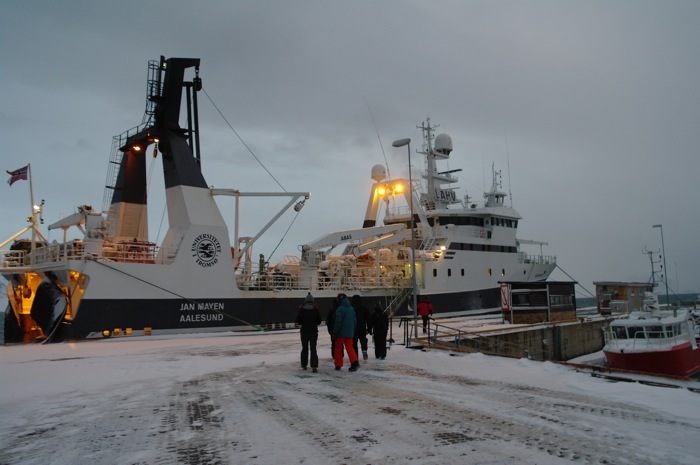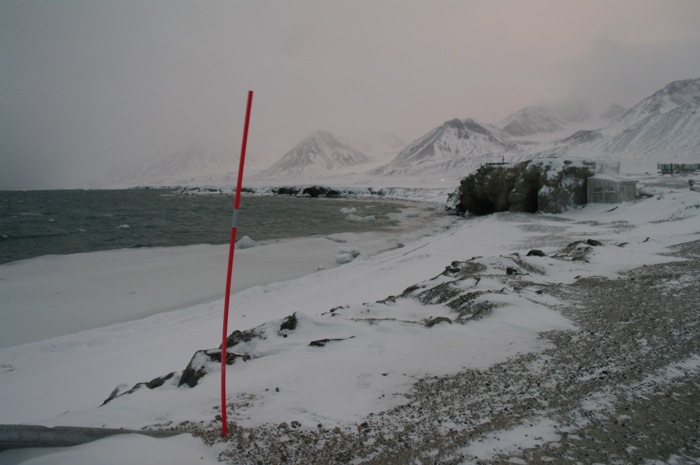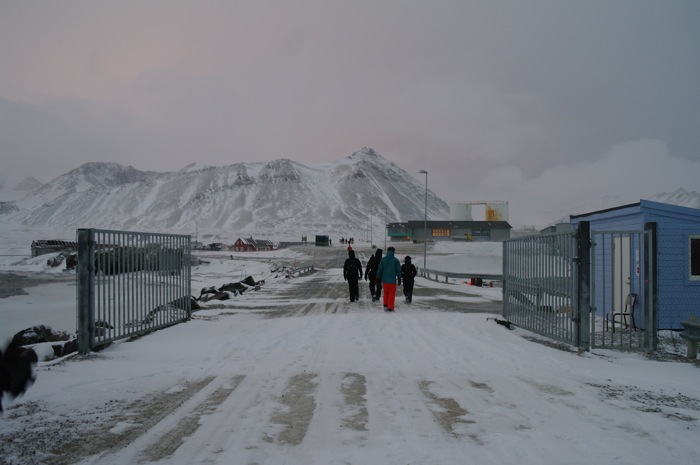19 October 2010 – Ny Ålesund

 Anchored in the Kongsfjorden, at the wharf in Ny Ålesund – the world’s northernmost permanent community, a town of less than 200 scientists from several countries. It is only around minus one, but the windchill is extreme. Snow is blowing like blossom and smoke across everything. I’m not really conscious of the mountains all around, only of the difference, the grey wind, the blustering difference of this place after days in the wilderness.
Anchored in the Kongsfjorden, at the wharf in Ny Ålesund – the world’s northernmost permanent community, a town of less than 200 scientists from several countries. It is only around minus one, but the windchill is extreme. Snow is blowing like blossom and smoke across everything. I’m not really conscious of the mountains all around, only of the difference, the grey wind, the blustering difference of this place after days in the wilderness.
The pier is shared by a large research vessel, the Jan Mayen; owned by the University of Tromsø. To get off the Noorderlicht – which has been clunking back and forth against the wharf all night, and rocking almost as though we’re at sea – we have to be helped up onto the gunwale and leap across nearly a metre of space, to be caught by waiting hands on the other side. Between pier and ship are heavy old tyres, covered in snow, and below them, the cold grey water. Again, treacherous – everything is treacherous.
I walk alongside the Jan Mayen, surprised to be in a place where there are structures, things made of other things, huts and fences and signs. The sky is dull and pure, a clean blue-grey carrying snow from the south. Blowing it all over the road in endless, smoky gusts.
Turning from the pier to face the main street, I see it: the town, a safe haven. The buildings are warm and pretty, the mountains in the background are majestic instead of threatening; there is a sense of their distance. There are roads, made of hard dirt and covered in snow, but roads nevertheless. In the tiny bay on the other side from the pier, large chunks of blue glacier ice are floating roughly, and along the shore thick strange layers of foam float and slursh around rocks and smaller bittybergs.
I could live here, I could live HERE, I think. Not for me the trapper’s hut, no longer for me the idea of wilderness. That romance is smashed to pieces and lies under black swathes of rubble. Here is the place, finally, where I imagine myself belonging.
The huts are many-coloured, wooden, rustic, creamy opal, mustard and light blue, and dark red. With their four-paned windows dressed neatly in white; and between them, blue and orange poles to delineate the road, which is some places bare and elsewhere under 20cm of snow. The snow is like vanilla bean icecream, not the shattering white of the northern wilds, but specked almost imperceptibly with near-infinite fragments of earth. We wait in the cold outside the weather balloon hut, for 12.45pm.
Inside the hut, the weather balloon, like a long condom, is inflated with helium from a tap, and hisses wildly until it is full and round, rolling on its axis gently clockwise until Sebastian, the scientist, attaches a little white box to it with fishing line. The side wall of the shed is opened up and he takes three light steps out before releasing the swinging globe to the wind, which today is so strong that the creamy round shape lifts and flies up and distant in a few seconds, swept higher and higher till it’s barely visible in sky that is already darkening above the mountains. I walk back towards the dock and the wind is raging, the snow is whipping away forever, whirlwinding, scurrying out of the town. At the tiny bay, the water has turned brown and is churning around the flaking, floating slush, whose surface is viscous, greasy, dirty. The ice chunks have been blown closer to land, a couple chunking around the shallows and another further out. It is a washing machine of messy water, and in a couple of hours we’ll be sailing in it.
Our tour of the Jan Mayen is interesting, in that way of machinery and the maritime thickness of green-painted deck, of white rails, of cogs and funnels and liferafts and the smell of cigarette smoke just inside the room where we take off our shoes. The bridge is spacious, a giant console centred around a big sci-fi chair and a faceted desk full of dials and screens. Down in a lab, a scientist tells us about the bathymetric data-gathering that is going on, to study the action of ancient glacier ice on the sea floor.
But I can’t wait to get back onto the Noorderlicht, and I can’t wait for lunch, and then after lunch I’m so full, stuffed and overweighted with the food, although the food isn’t even heavy. My body is well out of its comfort zone, dehydrated but eating too much, forced to adjust minute-by-minute, accepting hunger than feasting when it is put in front of me, sleeping all night and in whatever other snatches I can grab. Always in one state of bodily control and waiting for the next requirement, for the next adaptation to take place. I’m in automatic motion from one physical state and physical stress to the next, and the next, and the next.




